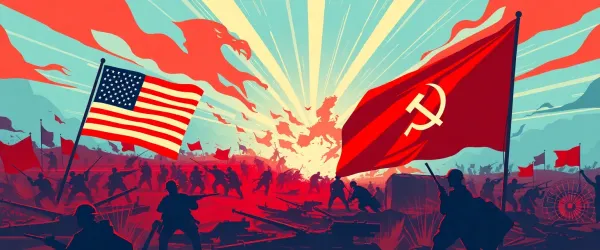
Did EEUU help more than the Soviet Union in ending the World War 2?
It is undetermined whether the USA helped more than the Soviet Union in ending World War 2

Respuesta
It is difficult to definitively conclude that the US helped more than the Soviet Union in ending World War II, as the provided sources highlight distinct and crucial contributions from both nations, particularly concerning the defeat of Nazi Germany. The United States provided massive military and economic assistance to its allies, including the Soviet Union, through the Lend-Lease program . This aid, totaling $11.3 billion (equivalent to $152 billion in 2023) to the Soviet Union, included more than 400,000 jeeps and trucks, 14,000 aircraft, 8,000 tractors, 13,000 battle tanks, 4.5 million tons of food, and 2.7 million tons of petroleum products . Lend-Lease shipments also covered critical aspects of Soviet production like explosives, aluminum, nonferrous metals, and radio communications . For instance, the US provided over one-third of all explosives used by the Soviet Union, 55% of all aluminum and over 80% of copper . Aviation fuel from Lend-Lease was equivalent to 57% of what the Soviet Union produced, and much of it was high-octane fuel crucial for modern military aircraft . The program also significantly propped up the Soviet railway system by providing nearly 2,000 locomotives and numerous boxcars, and almost half of all rails used by the Soviet Union during the war . Notably, Soviet leaders themselves acknowledged the significance of this aid: Joseph Stalin stated at the Tehran Conference in 1943 that "Without the machines we received through Lend-Lease, we would have lost the war" . Nikita Khrushchev echoed this, saying, "If the United States had not helped us, we would not have won the war" . This aid filled critical gaps in Soviet production when their industrial capacity was displaced and rebuilding after the initial German invasion, and provided essential sustenance, helping to stave off famine . The US also played a direct role in the defeat of Japan through two devastating atomic bomb attacks, which, coupled with the Soviet invasion of Manchuria, led to Japan's surrender . Furthermore, the US, along with Great Britain, finally opened a second front in Western Europe in 1944, draining Nazi Germany's strength on two fronts .
However, the Soviet Union bore the overwhelming brunt of the fighting against Nazi Germany on the Eastern Front, which is described as the largest military confrontation in history and "decisive in determining the outcome in the European theatre" . More than 80% of all combat during World War II took place on the Eastern Front . The Red Army inflicted approximately 70% of the battle deaths suffered by the German Wehrmacht . The human cost to the Soviet Union was staggering, with an estimated 24 million to 27 million total civilian and military deaths, representing about a third of all World War II casualties, and significantly more than any other nation . This includes 8.8 million to 10.7 million military deaths according to Russian Ministry of Defense figures, though some Russian scholars argue the number could be higher, up to 14 million . The Eastern Front saw horrific brutality, scorched-earth tactics, and genocidal campaigns by the Nazis . Major turning points in the war, such as the Battle of Stalingrad, where the Soviets suffered over 2 million casualties but encircled 290,000 Axis troops, and the Battle of Kursk, which terminated German offensive strength, occurred on the Eastern Front . The Red Army's winter counteroffensives, like the one in December 1941, pushed back exhausted German forces and created a critical situation for them . The Soviet Union also played a central role in the final defeat of Nazi Germany by capturing Berlin in one of the last major offensives in the European theater . The Battle of Berlin, from April 20 to May 2, 1945, involved over 1.5 million Soviet soldiers, 8,500 warplanes, and 6,500 tanks, with Soviet artillery firing nearly two million shells . The city's garrison surrendered to the Red Army on May 2, and the general surrender of German forces in Europe was completed on May 8 (May 9 in the Soviet Union) . The Western Allies, including the US, had no plans to seize Berlin, with General Eisenhower seeing no need to suffer casualties by attacking a city that would be in the Soviet sphere of influence .
In conclusion, the statement "Did EEUU helped more than the Soviet Union in ending the word war 2?" is undetermined. While the United States provided indispensable material and economic aid through Lend-Lease, which was acknowledged as crucial by Soviet leaders themselves, the Soviet Union bore the vast majority of direct military engagement and casualties against Nazi Germany on the Eastern Front, which was the most significant theater of the war in Europe. The Eastern Front inflicted the highest proportion of German military deaths and saw decisive battles that turned the tide against Germany long before the major Western Front landings. Both nations made critical and distinct contributions, with the US providing the industrial and logistical support that enabled the Red Army's immense efforts, and the Soviet Union engaging in the primary ground combat and enduring the highest human cost against the Axis in Europe. The US also played a direct role in ending the war against Japan. Therefore, judging who "helped more" is subjective and depends on whether "help" is quantified by direct combat, casualties, or material support, and which theater of war is emphasized.
1
2
3
1
2
3
1
1
1
1
1
2
1
2
2
4
5
4
6
6
2
7
8
5
9
7
8
6
6
5
10
11
12
13
11
12
11
13
11


